Acrylic or cast-iron bath - which is better? Comparative review
Modern man is spoiled for comfort and does not imagine his existence without the so-called "benefits of civilization." The bathroom, equipped with the latest technology, occupies not the last place in their list.
It is important to understand what material plumbing is made of, because not only the appearance, but also the convenience of its use depends on this. A wide selection of offers can mislead consumers, agree? In order not to be disappointed in the purchase, you should know about the pros and cons of each model.
We suggest figuring out what is best - an acrylic or cast-iron bathtub, which option should be preferred and why. In the article we described in detail the characteristics, especially the operation of different fonts and care for them. A comparative assessment of the parameters will help to make a competent choice.
The content of the article:
All About Cast Iron Bathtubs
For the manufacture of sanitary equipment only high-quality alloy is used. Cast iron is cast in sand forms. After the workpiece cools down, it is cleaned and coated with enamel.
For this, a special powder is used, which, under the influence of high temperature, turns into an enamel coating. The walls of bathtubs from Russian manufacturers have a width of up to 1 cm, which, accordingly, increases their weight.
Leading European manufacturers produce products with walls up to 5 mm thick, while they are not inferior in strength to domestic counterparts. The composition of the enamel is also different.
Russian products are often coated with a composition with zirconium, and European products are coated with a mixture with titanium.
The latter option gives a more durable and smooth coating. The length of the baths of different manufacturers is approximately the same. Features of the technological process do not allow to produce products longer than 1.9 m.
Why choose such products
Cast iron bathtubs have a number of significant advantages.
We list the main ones:
- High strength. The metal from which they are made is tough and holds its shape well. Under no circumstances does the bottom of the bowl sag; it does not require additional supports in addition to the legs. Even if two people with a large weight take a bath, the bowl will not change its position and will not be deformed.
- Low thermal conductivity. Thanks to this, the hot water in the bath of this alloy does not cool for a long time. On average, it takes 8-10 minutes to get its temperature down one degree. Therefore, the time to soak in the foam without the forced addition of hot water is enough.
- Aesthetic appeal. Cast-iron bathtubs are coated with a special anti-corrosion coating, which helps the bowl maintain its original appearance for a long time.
- Resistance to temperature surges. The enamel is applied in an even smooth layer, the substances included in its composition make it insensitive to sudden changes in temperature.
- Good sound absorption. Thanks to this, you can draw water into the bowl almost silently, which is impossible, for example, for steel products.
The service life of plumbing with proper care of a cast-iron bath is much longer than that of equipment made of other materials and is at least 50 years.
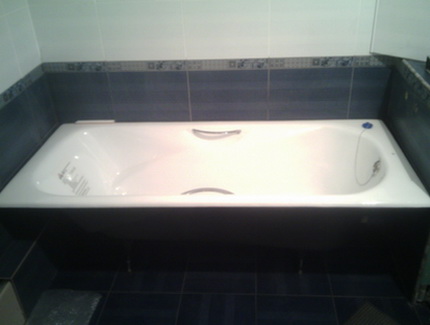
This is not to say that manufacturers produce cast iron bathtubs of various shapes. Due to the characteristics of the material, it is extremely difficult to do, but the products are equipped with functional additions: handles, hydromassage, etc.
With a large number of advantages, plumbing fixtures also have disadvantages. First of all, this, of course, is a big mass. The bath weighs an average of 120 kg.
It is clear that installation "alone" is not possible here. Moreover, such a product is difficult to transport and raise to any floor above the first. We have to use the services of movers, which entails additional costs.
Another disadvantage is the rather high cost of cast-iron bathtubs, especially if they are produced by a well-known company. Buying a cheap product of unknown origin is quite dangerous, because in this case its quality is not guaranteed.
Features of the care of cast-iron bathtubs
Cast iron bathtub replacement and enamel restoration - laborious and costly process. Therefore, it is worth saving a new product, then it will last a very long time. Caring for an enamel bath is quite simple. First of all, after each bath it should be washed.
Particles of fat and soap flakes are collected on the enamel, if they are not removed immediately, they will dry out and turn into hard-to-remove dirt. Therefore, you should take a soft sponge dipped in a solution of mild detergent and process the bowl.
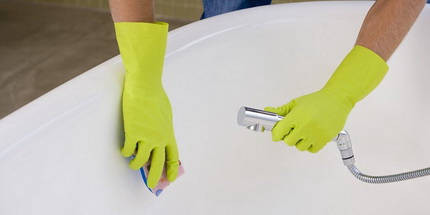
If there is no time for this, rinse the bath with hot water from the shower head. It is strongly not recommended to use powders and abrasive products for cleaning equipment. They will scratch the enamel, which will begin to deteriorate.
Formulations with acids corrode the enameled surface of the bath. It loses smoothness and becomes emery-like. Contamination easily adheres to such a surface and is very difficult to remove from it.
To cope with stains that appear on the enamel, you should use special tools. Bowl cover should be protected from chips. They can appear from objects falling from a height into the bath: glass bubbles, shower head, etc.
No need to put metal buckets or basins inside the container: they can damage the enamel. For the same reason, when bathing pets, especially large dogs, a rubber mat should be laid on the bottom.
More information about the methods and means for the care of cast iron bathtubs is written in this article.
Features of a high quality product
The store usually offers a large assortment of cast iron bathtubs.
A quality product can be easily recognized by several signs:
- perfectly smooth inner surface;
- uniformly colored enamel without spots and splashes;
- absence of defects such as chips and potholes on the outer surface of the product.
It’s good that the bathroom comes with a drain and all the necessary elements: legs, handrails, etc. It is desirable that the legs can be adjusted in height. This makes the product easier to install.
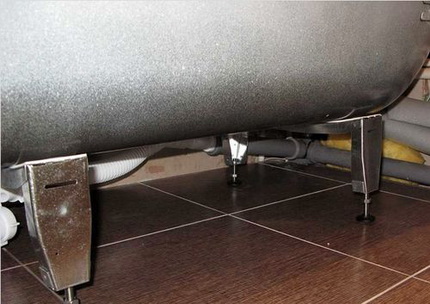
Acrylic bath: what the owner needs to know
Under the name acrylic bathtub in stores two completely different types of plumbing fixtures are sold. Their main difference lies in the material from which they are made. By and large, the properties of finished products depend on its characteristics.
The first type of bathtubs is made from pure or, as it is also called cast acrylic, the second from coextruded acrylic.
Before polymerization, various components are added to polymethylmethacrylate or PMMA to improve the properties of the future product. Due to this, the composite acquires a persistent color, ductility, maintainability and hygiene.
In addition, additives can be added to the plumbing acrylic to prevent the growth and growth of bacteria on the walls of the bowl.
Despite the fact that PMMA is used in the manufacturing process of both types of bathtubs, the result is different.
Products from molded acrylic are made as follows. First, high quality material is made. For this, the liquid compound is poured into sealed glass forms and sent to the steam oven for polymerization. The result is a high quality sheet solid material with a thickness of about 8 mm.
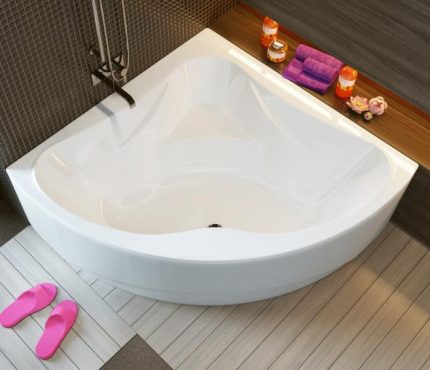
The resulting sheet is heated, after which it is stretched by vacuum to the desired size and formed. A reinforcing layer is applied to the back of the acrylic preform: a mixture of fiberglass and polyester resin.
Then, from an almost ready bowl, all excess is cut off, all the necessary holes are drilled. The workpiece is mounted on a power frame assembled under its construction and polished.
Products from two-layer plastic are made differently. In addition to PMMA, they also include acrylonetrile butadiene styrene or ABS, which is an elastic plastic.
During the production process, the melts of both compositions are simultaneously extruded through the nozzles of the apparatus and combined with each other. After solidification, a plastic structure is obtained having, on the one hand, a glossy acrylic surface, and on the other, an impact-resistant ABS base.
Pros and cons of acrylic products
The undoubted advantages of acrylic bathtubs include a small, up to 40 kg, weight. Such products are easy to transport, they do not create additional load on the floor. Installation of equipment is also greatly simplified. If desired, it can be performed by one person.
Products have sufficient strength, however, this applies to devices made of injection-molded acrylic. They are able to withstand even strong impacts with minimal losses.
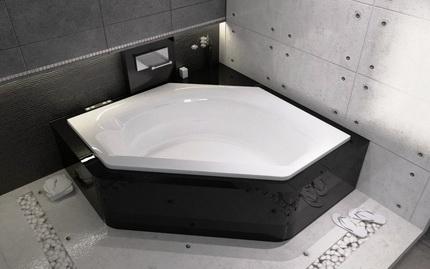
Among acrylic models, you can easily pick up a product for the interior of any style. The number of colors is also practically unlimited. The pigment is introduced into acrylic before polymerization, which allows to obtain a stable color that does not change with time.
Acrylic bathtubs have low thermal conductivity. The water collected in them retains its temperature for a very long time. It will take about 30-40 minutes to cool down by one degree, so periodic addition of warm water during the bath is not required.
In addition, with all its smoothness, acrylic has anti-slip properties, which makes carrying out water procedures safe.
The composite absorbs sound quite well, so the owner of the bath will not have to listen to the drum roll during the collection of water in the bowl.
Acrylic products are multifunctional.Simplicity in processing the material makes it possible to install all kinds of nozzles and nozzles for hydromassage, handrails of various shapes and configurations, lights, automatic overflow system and much more.
One of the main advantages of acrylic bathtubs is their maintainability. Small cracks, scratches or chips are restored very quickly and simply with the help of special compounds that are easy to buy at any hardware store.
An acrylic bathtub that has lost its attractive appearance can also be restored. There are two acceptable methods - you can insert inside acrylic liner or use loading method.
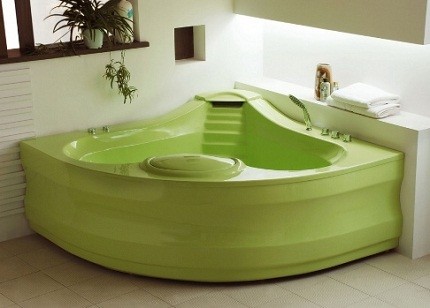
Both methods are quite effective and will help extend the life of your favorite bath. It must be admitted that all of the above advantages are inherent in most products from molded acrylic.
Models of two-layer plastic are coated with PMMA only on the inside and the layer of this coating is very thin. ABS, which, in fact, makes up about 80% of such a bowl, absorbs moisture and collapses quite quickly.
A disadvantage of acrylic baths is considered to be sensitivity to high temperature. PMMA melts at a temperature of 160 ° C; therefore, when pouring hot water, the plastic softens a little and can be deformed. For this reason, manufacturers recommend first pouring cold water into the bath and diluting it with hot water.
Sensitive composite to alcohol-containing substances. In no case should they fall onto the surface of such a bath.
Another disadvantage is the fragility of acrylic products. A strong blow, especially if an object falls from a height, can destroy plastic. At the same time, serious deformations are not always amenable to restoration and the bath has to be replaced with a new one. Under the weight of a large person, acrylic can “play” and bend, which is not very pleasant in the process of swimming.
The disadvantages include the high cost of quality molded products.
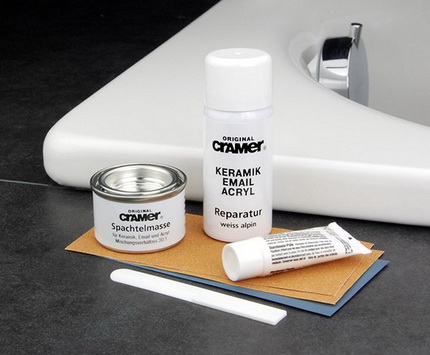
How to care for acrylic equipment
Contrary to popular belief, care for acrylic products is quite simple. Especially if you follow certain rules.
Rule number 1. The acrylic surface should be washed after each use or at least rinsed with hot water. Pollution frozen on the surface of acrylic turns into stubborn stains.
Rule number 2. Only special products or mild detergent solutions can be used to clean products. All cleaning products with abrasives are enemies of acrylic. They scratch the gloss and eventually turn the shiny bathtub into a matte finish.
Rule number 3. Taboo for chlorine products and solvents. When you try to disinfect the cup with one of these compositions, you can only achieve a sharp clouding of the coating. If you use the drug a second time, the bowl of acrylic is covered with a network of small pores.
All solvents, including acetone, also act on it. At first it becomes cloudy, if the composition is not immediately washed off, with long contact it simply eats away the surface of the bowl. Similarly affects acrylic ammonia and formaldehydes. Do not allow their contact with the bath.
Rule number 4. When rust spots or calcareous deposits appear on the surface, one should not act by folk methods, only special means for acrylic should be used.
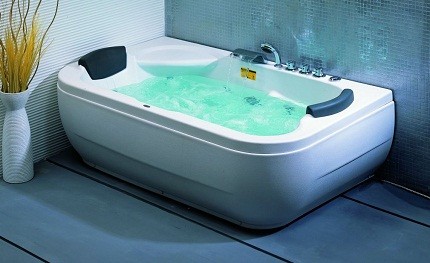
On our website there is a series of articles devoted to the care of acrylic plumbing, we recommend that you read:
How to “know” quality acrylic
When it comes to choosing acrylic bathtubs high quality, you need to understand that most often only the injection option is meant. Two-layer plastic almost never falls under this definition. Therefore, the first thing to do is to determine the composition of the model you like.
It is very easy to do. On the cut of the bath rim, the casting acrylic will have two layers, coextruded - three.
In addition to this should be present:
- Smooth surface - any roughness indicates low quality.
- Structural strength - when pressed, the bath should not “play”.
- Same material thickness on all surfaces of the product - checked using a flashlight.
- Simple enough form - too complex configuration often reduces the strength of the product.
It is worth paying attention to the thickness of the sides. For high-quality products, they cannot be thinner than 4 mm. Often they are even wider - about 6 mm. For low-quality bathtubs, the sides have a width of 2 to 4 mm.
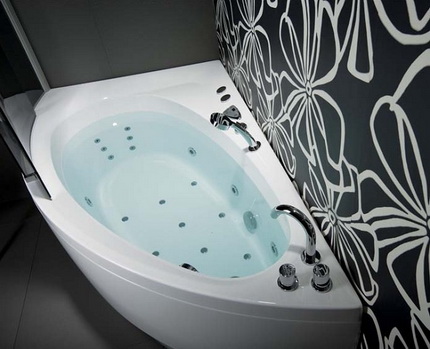
Compare acrylic and cast iron: important features
And yet, when choosing a bath, prefer acrylic or cast iron? To finally dispel all possible doubts, we compare both options in several important ways.
Durability and strength
In comparison of these indicators, of course, cast iron wins. It is not susceptible to corrosion and is highly resistant to any mechanical stress. The maximum that he faces in this sense is enamel cleavage. Such damage, if desired, can be restored by restoring the enamel layer.
Cast iron holds its shape very well, does not bend and has served the owner for more than a dozen years.
Acrylic is in many ways inferior to him. The term of its operation depends entirely on the quality of the product and on how it was manufactured. Two-layer baths rarely serve more than 5-7 years; for castings, this period is certainly longer. But still, it is not as large as that of cast iron: only 10-15 years.
The strength of acrylic products is low. Even the best baths can bend under the weight of a person, which creates a certain discomfort and a sense of instability.
Appearance and design features
Acrylic products simply do not have competitors in this area. The technology of their production allows you to carry out any design ideas. Bathtubs can have various forms, up to the most whimsical.
The ease of processing plastic allows you to make a large number of holes for installing additional equipment, which makes it possible to equip acrylic bowls with any functionality.
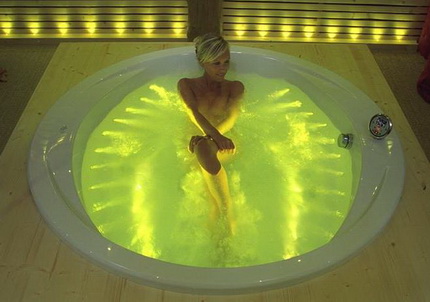
There are no restrictions in the choice of colors of products. Cast-iron bathtubs cannot boast of such a variety. Heavy metal does not imply the use of designer refinements in processing.
The lineup of cast iron products is very small, the number of forms is also small. Only the legs of the structure and, possibly, handrails are exposed to the decor. There is no variety of colors either - all the devices are mostly white.
Mounting Features
Everyone knows that cast iron bathtub installation It’s quite complicated due to its mass - any model weighs more than 100 kg. To this you need to add the mass of a bathing person and the water drawn into the bowl.
The result is more than 220-250 kg, which can be considered a serious load on the floor. Concrete, no doubt, can withstand it, but wood structures, for example, will need to be further strengthened. However, this is where the difficulties with installing a cast-iron bathtub end.
It is quite difficult to deliver it to the installation site, especially if it is located on one of the upper floors. Due to its massiveness, it is very stable and all the installer needs is to level it in height. Why are legs adjustable?
Admittedly, installing acrylic products is also quite difficult. The main difficulty here is the mandatory presence of a metal frame, which is necessary to strengthen the bowl. For each model, the design is specially developed. Bathtubs are equipped with frames even in production.
During installation, you must first properly assemble the frame and connect it to the bowl. It seems to many that such a design will not be enough to make the acrylic bathtub stable.
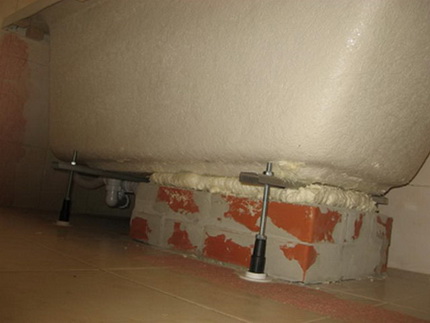
In this case, an improvised frame is additionally used or a brick pillow is assembled as a base. All this, of course, makes it difficult installation of acrylic products.
But otherwise it goes quite simply, given that the weight of the frame and the bath itself is small. If desired, any home master will cope with such work alone.
Cost and additional costs
It must be admitted that the price of high-quality products made of cast iron and acrylic differ slightly. In both cases, you can purchase the simplest model for relatively little money, but all additional elements will significantly increase this amount.
Price is determined by brand, design and quality. The acceptable ratio of these characteristics for each buyer determines for himself.
It is important to understand that it makes no sense to buy too cheap and obviously low-quality thing. The funds spent on its purchase and installation can be considered discarded, because it will not last long.
Additional costs include the cost of purchasing special cleaning products for bath care. Such necessarily required for acrylic, cast-iron products in this regard are less whimsical.
Conclusions and useful video on the topic
Comparison of the technical and practical qualities of plumbing for a reasonable choice of a bathtub from innovative acrylic or traditional cast iron:
Criteria for choosing a cast-iron bowl:
How to choose the right acrylic bath?
Acrylic bathtubs are believed to be ideal for high-rise buildings - they are easy to transport, easy to install. Among them, you can easily choose a model for the smallest bathroom. Cast iron bowls are better suited for a private house or cottage.
However, these are only recommendations of practitioners. Both options have disadvantages and advantages. Grace of acrylic or practicality of cast iron: the final choice for the buyer.
Looking for a practical, beautiful and durable bath? Or have experience operating cast iron or acrylic plumbing? Please share with your readers your impressions of using different types of bathtubs, ask questions and participate in discussions. The comment form is located below.

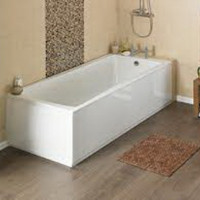 Which bath is better - acrylic or steel? Comparative review
Which bath is better - acrylic or steel? Comparative review 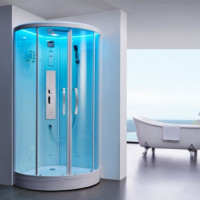 Bath or shower - which is better? Comparative review
Bath or shower - which is better? Comparative review 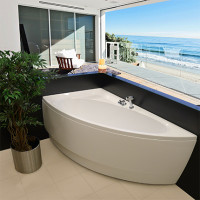 Acrylic bath: pros and cons, reviews, selection tips
Acrylic bath: pros and cons, reviews, selection tips 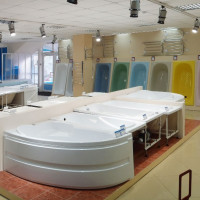 How and which bath is best to choose: an overview of options and recommendations for choosing
How and which bath is best to choose: an overview of options and recommendations for choosing 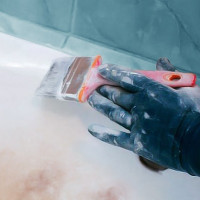 Liner or bathtub - which is better? Comparison of technological and technical characteristics
Liner or bathtub - which is better? Comparison of technological and technical characteristics  Bathtub for two: rules for choosing a double bathtub + review of the best manufacturers
Bathtub for two: rules for choosing a double bathtub + review of the best manufacturers 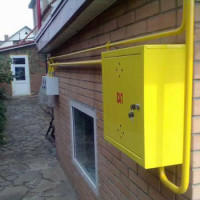 How much does it cost to connect gas to a private house: the price of organizing gas supply
How much does it cost to connect gas to a private house: the price of organizing gas supply  The best washing machines with dryer: model rating and customer tips
The best washing machines with dryer: model rating and customer tips  What is the color temperature of light and the nuances of choosing the temperature of the lamps to suit your needs
What is the color temperature of light and the nuances of choosing the temperature of the lamps to suit your needs 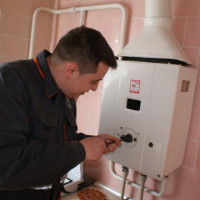 Replacement of a geyser in an apartment: replacement paperwork + basic norms and requirements
Replacement of a geyser in an apartment: replacement paperwork + basic norms and requirements
As for me, a cast-iron bath is still better. With proper care, it will last a much longer time than acrylic.Yes, you have to puff while you install, because it is quite heavy, but you do not have to change it every 5 years. I have had a cast-iron bathtub in my house for forty years. Recently restored it with a special paint. White now, like new. It will stand still for many years.
A cast iron bathtub has been installed in our house for several years, and when a child appeared due to sleep problems, we often began to bathe our daughter in different herbs. After a few weeks, the bath began to acquire a yellowish tint. I pretty tormented to bring it into proper form and return the white color. I decided to temporarily put an acrylic liner without gluing, so as not to spoil the expensive cast-iron plumbing.
Modern enamels for cast-iron bathtubs are made using titanium salts, which markedly increased enamel strength. Now it can be washed with almost any chemistry, rubbed with brushes, etc. But the old-style baths with enamel based on zirconium salts are more susceptible to corrosion - any scratch and there is a risk of rust.
So be sure to pay attention to this when buying. And the cast-iron bath is more durable, so I like it more.